
The Tai ethnic group migrated into mainland Southeast Asia over a period of centuries. The word Siam may have originated from Pali or Sanskrit श्याम or Mon ရာမည, probably the same root as Shan and Ahom. Xianluo was the Chinese name for Ayutthaya Kingdom, merged from Suphannaphum city state centered in modern-day Suphan Buri and Lavo city state centered in modern-day Lop Buri. To the Thai, the name has mostly been Mueang Thai.
The Mon are an ethnic group who inhabit Lower Myanmar's Mon State, Kayin State, Kayah State, Tanintharyi Region, Bago Region, the Irrawaddy Delta, and several areas in Thailand. The native language is Mon, which belongs to the Monic branch of the Austroasiatic language family and shares a common origin with the Nyah Kur language, which is spoken by the people of the same name that live in Northeastern Thailand. A number of languages in Mainland Southeast Asia are influenced by the Mon language, which is also in turn influenced by those languages.

The Ayutthaya Kingdom, the Empire of Ayutthaya (1569–1767), or the Ayutthaya Empire, was a Siamese kingdom that existed in Southeast Asia from 1351 to 1767, centered around the city of Ayutthaya, in Siam, or present-day Thailand. European travellers in the early 16th century called Ayutthaya one of the three great powers of Asia. The Ayutthaya Kingdom is considered to be the precursor of modern Thailand, and its developments are an important part of the history of Thailand.
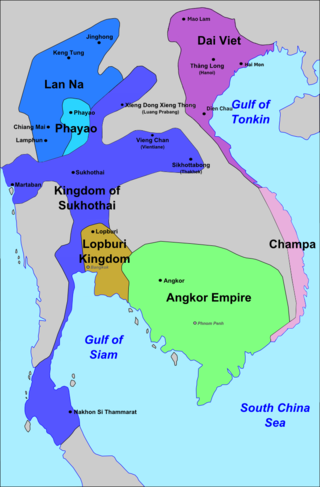
The Sukhothai Kingdom or the Northern Cities was a post-classical Thai kingdom (mandala) in Mainland Southeast Asia surrounding the ancient capital city of Sukhothai in present-day north-central Thailand. The kingdom was founded by Si Inthrathit in 1238 and existed as an independent polity until 1438, when it fell under the influence of the neighboring Ayutthaya after the death of Borommapan.
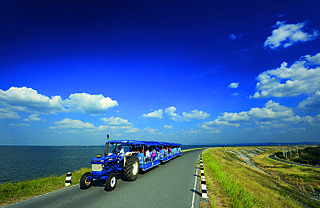
Lopburi is a province in the central region of Thailand. The province is divided into 11 administrative districts, and Mueang Lopburi district is the capital. With over 750,000 people, the province is Thailand's 36th largest area and 32nd most populous. There are eight neighboring provinces, Phetchabun, Chaiyaphum, Nakhon Ratchasima, Saraburi, Phra Nakhon Si Ayutthaya, Ang Thong, Sing Buri, and Nakhon Sawan.

Phra Nakhon Si Ayutthaya is one of the central provinces (changwat) of Thailand. Neighboring provinces are Ang Thong, Lopburi, Saraburi, Pathum Thani, Nonthaburi, Nakhon Pathom and Suphan Buri.

Haripuñjaya was a Mon kingdom in what is now Northern Thailand, existing from the 7th or 8th to 13th century CE. Its capital was at Lamphun, which at the time was also called Haripuñjaya. In 1292 the city was besieged and captured by Mangrai of the Tai kingdom of Lan Na.
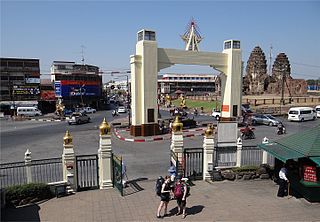
Lopburi is the capital city of Lopburi Province in Thailand. It is about 150 kilometres (93 mi) northeast of Bangkok. It has a population of 58,000. The town covers the whole tambon Tha Hin and parts of Thale Chup Son of Mueang Lopburi District, a total area of 6.85 km2.

King Narai the Great or Ramathibodi III was the 27th monarch of Ayutthaya Kingdom, the 4th and last monarch of the Prasat Thong dynasty. He was the king of Ayutthaya Kingdom from 1656 to 1688 and arguably the most famous king of the Prasat Thong dynasty.

Dvaravati was an ancient Mon kingdom from the 7th century to the 11th century that was located in the region now known as central Thailand. It was described by the Chinese pilgrim in the middle of the 7th century as a Buddhist kingdom named To-lo-po-ti situated to the west of Isanapura (Cambodia) and to the east of Sri Ksetra (Burma). Dvaravati also refers to a culture, an art style, and a disparate conglomeration of principalities of Mon people. Archaeological research over the past two decades or so has revealed the presence of a "Proto-Dvaravati" period which spans the 4th to 5th centuries, and perhaps earlier.

Thai art refers to a diverse range of art forms created in Thailand from prehistoric times to the present day, including architecture, sculpture, painting, textiles, decorative arts, crafts, ceramics, and more. While Buddhism has played a significant role in Thai art, with many sculptures and paintings depicting Buddha images and religious themes, nature, including flora and fauna, as well as mythical creatures, has been a major inspiration for Thai art, with colorful motifs appearing in various types of art forms. In contemporary Thai art, traditional works remain significant and continue to influence artists' concepts.

Nakhon Pathom is a city in central Thailand, the former capital of Nakhon Pathom province. One of the most important landmarks is the giant Phra Pathommachedi. The city is also home to Thailand's only Bhikkhuni temple Wat Song Thammakanlayani (วัดทรงธรรมกัลยาณี), which is also open to women from abroad.
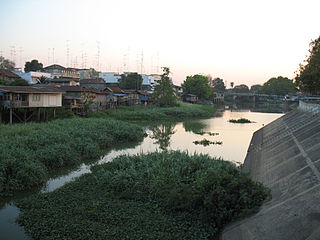
The Lopburi River is a tributary of the Chao Phraya River in central Thailand. It splits from the Chao Phraya river at Tambon Bang Phutsa, Singburi. Passing through Tha Wung district and the town of Lopburi, it enters the Chao Phraya together with the Pa Sak River at the town of Ayutthaya. It is about 95 kilometres (59 mi) long.

Mueang Lopburi is the capital district of Lopburi province, central Thailand. The district is home to Khok Kathiam Air Force Base.

The architecture of Thailand is a major part of the country's cultural legacy and reflects both the challenges of living in Thailand's sometimes extreme climate as well as, historically, the importance of architecture to the Thai people's sense of community and religious beliefs. Influenced by the architectural traditions of many of Thailand's neighbors, it has also developed significant regional variation within its vernacular and religious buildings. Although Siam urged to identify themselves as a modernized state, Western culture and influence was undesirable and inevitable. In an attempt to become distinguished, Thailand's ruling elite gravitated toward selective Modernization to avoid the undesired Western influence.

Before the Tai people's southward migration from Guangxi since the 4th century, the Indochinese peninsula had already been populated by Australo-Melanesians who by around 30,000 BP had spread into all sub-regions. They left traces of the first local culture - the Hoabinhian, a name assigned to an industry and cultural continuity of stone tools and flaked cobble artifacts that appears around 10,000 BP in caves and rock shelters first described in Hòa Bình, Vietnam, later also documented in Terengganu, Malaysia, Sumatra, Thailand, Laos, Myanmar, Cambodia and Yunnan, southern China.

The Lavo Kingdom was a political entity (mandala) on the left bank of the Chao Phraya River in the Upper Chao Phraya valley from the end of Dvaravati civilization, in the 7th century, until 1388. The original center of Lavo civilization was Lavo, but the capital shifted southward to Ayodhaya, the port city on the right side of the Ayutthaya island around the 11th century, whereupon the state was incorporated into the Ayutthaya Kingdom in the 14th century.

Wat Arun is one of two khwaeng (subdistrict) of Bangkok Yai District, Bangkok, apart from Wat Tha Phra. It can be considered an important area in terms of history and tourism.
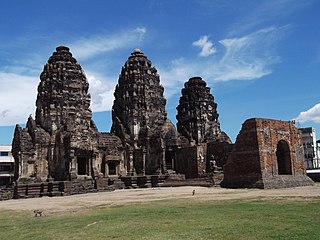
Phra Prang Sam Yot, also known as Phra Prang Sam Yod, is a 13th-century temple in Lopburi, Thailand. The temple is currently a popular tourist destination.

Si Thep Historical Park is an archaeological site in Thailand's Phetchabun province. It covers the ancient city of Si Thep, a site inhabited from around the third to fifth century CE until the thirteenth and spanning cultural periods from late prehistory to Dvaravati and the Angkorian Khmer Empire. Si Thep was one of the largest known city-states that emerged around the plains of central Thailand in the first millennium, but became abandoned around the time the Thai-speaking cities of Sukhothai and later Ayutthaya emerged as new centres of power in the Chao Phraya River basin.
























